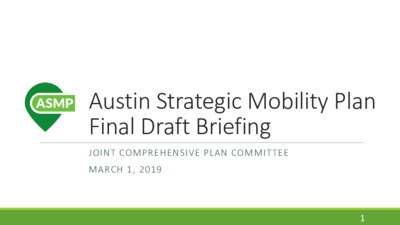4a — original pdf
Backup

Austin Strategic Mobility Plan Final Draft BriefingJOINT COMPREHENSIVE PLAN COMMITTEEMARCH 1, 20191 Agenda•Schedule•Motivation Behind the Plan•ASMP Draft•Content Outline•Elements of the Plan•Top Strategies•Chapter 2: Managing Our Demand•Phase III Feedback•Next Steps2 Schedule3EstablishAdvisoryCommittee &PublicEngagementPlanPhase II OutreachApproval Process startsOct Nov Dec Jan Feb Mar Apr May Jun Jul Aug Sep Oct Nov Dec Jan Feb Mar Apr May Jun Jul Aug Sep Oct Nov Dec Jan Feb Mar 201620172018Project Initiation & Phase I Public OutreachScenario Planning/Analysis & Phase II Public OutreachPreferred Strategy & Phase III Public OutreachPlan Review& AdoptionPhase I Outreach2019Phase III OutreachMobility Strategy review Motivation for the Plan4 MotivationforthePlan50%50%203974% drive alone today vs. 50% in 2039Sustainable ModesDrive Alone74%4%8%11%1%2%TODAYDrive AloneTransitTeleworkCarpool / Taxicab /OtherBicycleWalk5 Mode Share Targets74%4%8%11%1%2%TODAYDrive AloneTransitTeleworkCarpool / Taxicab /OtherBicycleWalk50%16%15%11%4%4%20396 ASMP Final Draft Plan7 Policy Document, Street Network Table + Map8 Prioritizing Our SafetySafety CultureDesigning for SafetySafe BehaviorsSupplying Our Transportation InfrastructureSidewalk SystemRoadway SystemPublic Transportation SystemBicycle SystemUrban Trail SystemCondition of InfrastructureEmerging Mobility SolutionsAviationManaging Our DemandLand UseParkingCurb ManagementTransportation Demand Management ProgrammingShared MobilityOperating Our Transportation NetworkTransportation OperationsClosures and DetoursGoods MovementProtecting Our Health and EnvironmentPublic HealthAir and ClimateWater and StormwaterLand and EcologySupporting Our CommunityEquityAffordabilityAccessibilityPublic InteractionImplementing Our PlanDataCollaborationFinancial StrategiesAction TableChapters & Subchapters9 How do we get to 50/50?126 Policies100s of multimodal projects to achieve ASMP goals10 Elements of the PlanIndicators + Targets:More specific measures of our goals which help us know how well we are achieving them. Some indicators have identified targetsnecessary to make ambitious yet reasonable progress toward a goal within a specified timeline. Policies:A definite course or method of action to guide and determine present and future decisionsActions: Steps necessary to support policies, programs, and projects11 Elements of the PlanPriority Networks: Designated for the roadway, public transportation, and bicycle systems to show where modes are prioritized to improve operationsTransportation Network Maps: Identify possible projects the City may pursue in the next 20 years based on a variety of factors, including the evolving needs of the transportation network, engineering analysis, public input, and available fundingStreet Network Table:Inventory of our streets and their future conditions, which will be used to identify right of way dedication requirements12 Top Strategies•Reduce traffic fatalities, serious injuriesby focusing on safetyculture, behaviors•Move more peopleby investing in public transportation•Manage congestion by managing demand•Build active transportation access for all ages and abilitieson sidewalk, bicycle, and urban trail systems•Strategically add roadway capacityto improve travel efficiency13 Top Strategies•Connect people to services and opportunities for better health•Address affordability by linking housing and transportation investments•Right-size and manage parking supply to manage demand•Develop shared mobility options with data and emergingtechnology•Build and expand community relationships with plan implementation14 Chapter 2: Managing Our Demand15 16 17-Examples 18The Imagine Austin Growth Concept is supported by the Transit Priority Network, linking land use with transportation. By providing fast, reliable, and efficient transit options along these Imagine Austin Corridors and into our Activity Centers, we will be able to promote infill and redevelopment in these desired locations. This linkage should reduce per capita car use and increase walking, bicycling, and transit use. Planning Commission Working Group Feedback19Land Use:•Transit Priority Network with Imagine Austin Growth Concept (pg. 37)•Updating Transportation Element of Growth Concept with the ASMP•Final draft plan includes whattransit-supportive densities are•Standards for both residential and commercial (pg. 36)•Indicators for Land Use (pg. 35) •VMT; people living + working within ½ mile of Transit Priority Network and AAA bicycle facilities; number of developments funding multimodal improvements•See action items in Land Use, Collaboration and Financial Strategies•21, 234, 235 Planning Commission Working Group Feedback20Development Mitigation:•Street Impact Fee (pg. 255, 262, 267)•General mitigation discussion (pg. 40)•Land Use Indicator: Increase the number of developments contributing to transit, walking, bicycle, and shared mobility improvements (pg. 35)•See action items in Collaboration and Financial Strategies•247, 264, 268 Planning Commission Working Group Feedback21Parking and Curb Management:•Discussion on dynamic/flexible pricing and utilization indicators (pg. 44)•Target: Average of 85% parking utilization for managed on-street parking•Shared parking encouragement and retrofitting parking garages (pg. 45)•See actions in Parking and Curb Management•26, 27, 28, 29, 30, 31, 32Transportation Demand Management Programming:•New mover outreach, carpool/HOV lanes are incorporated•See actions in many different sections•42, 58, 60, 75, 87, 165, 206Other:•Grid connectivity both in Land Use and Roadway System sections•Goods Movement section discusses deliveries and use of right of way How the elements work together –Land Use ExamplePolicy: Promote transit-supportive densities along the Transit Priority NetworkExample Programs/Projects: Small area planning, corridor planning, density bonus programs, Chapter 380 incentive programIndicator: Increase the number of people living and working within a ½ mile of the Transit Priority NetworkAction Item Example(s): ◦21 -Update the land development code to: -require a more compact and connected street network -allow for and incentivize transit-supportive densities and require a mixture of land uses along the Transit Priority Network -allow for missing middle housing types, including mixed-use infill development types. ◦22-Conduct corridor-based land use planning in parallel with corridor mobility planning and implementation to calibrate zoning and land development code requirements with needs, constraints, and opportunities to create cohesive multimodal corridors, quality built environment, and transit-supportive and context-sensitive density.22 Path to Completion•Boards & Commissions: •Zoning and Platting Commission (March 5 & March 19)•Environmental Commission (March 6)•Planning Commission (March 12 & March 26)•Urban Transportation Commission (March 18)•& Others•City Council•March 7 –Set Public Hearing for March 28•March 28 –City Council Public Hearing, Ordinance Readings23 24For more information, visit our website: •Draft ASMP Policy Document•Policies•Indicators + Targets•Actions•System Maps•Street Network Table + Map•Future meeting details•Previous engagement resultsaustintexas.gov/ASMP Thank you25AUSTINTEXAS.GOV/ASMP